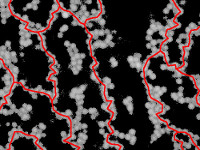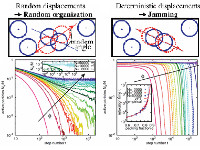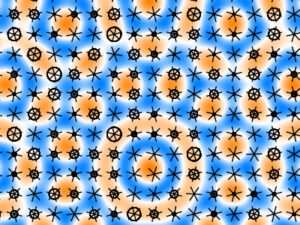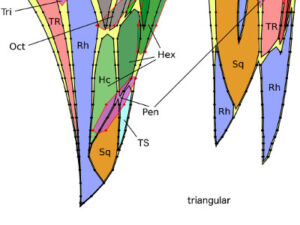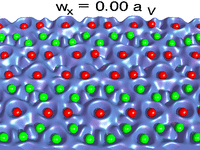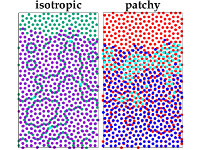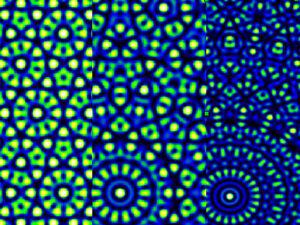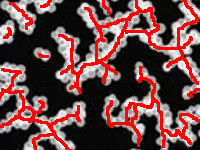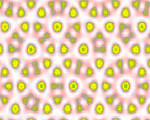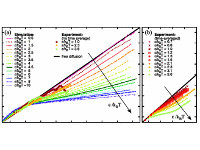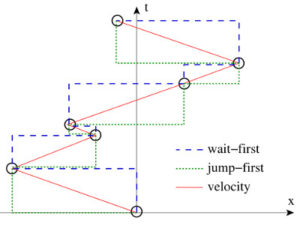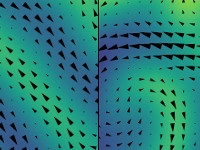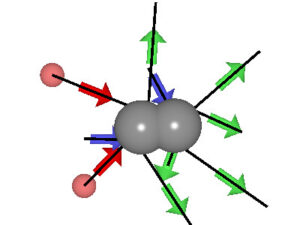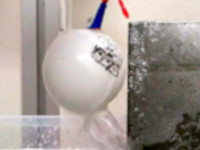Research
Systems in Non-Equilibrium and Biology, Jamming, Crowding, Glassy Dynamics, and Gels:
Breakdown of dynamics
T. Axmann and M. Schmiedeberg and for anisotropic systems in cooperation with A. Härtel (Freiburg) Selected Publications: Supported within the Emmy-Noether-Program of the DFG (Project number 191633488) and by a grant of the DFG (Project number 531383052). |
Gel formation
The slowdown of dynamics during gelation in colloid-polymer mixtures is attended by the formation of directed chains of colloids. This structural transition corresponds to a directed percolation transition. We are interested in the formation and ageing dynamics of such gel network structures. M. Gimperlein and M. Schmiedeberg in cooperation with the group of S.U. Egelhaaf (Düsseldorf) Selected Publications: |
Jamming and the energy landscape of non-equilibrium transitions
We explore non-equilibrium transitions like thermal jamming or the clustering transition by exploring the energy landscape of passive or active soft particulate systems. We want to extend these studies to other non-equilibrium or biological systems. T. Axmann, M. Gimperlein and M. Schmiedeberg in cooperation with M. Maiti (Münster) Selected Publications: Supported by a grant of the DFG (Project number 262587878). |
Complex Colloidal Structures:
Complex structures obtained with patchy colloids
We are interested how preferred binding angles in the case of patchy colloids influence the resulting self-assembled structures. A phase field crystal model is developed for a theoretical description. R. Weigel and M. Schmiedeberg Selected Publication: Supported by a grant of the DFG (Project Number 374790102). |
Colloids with complex interactions or on incommensurate substrates
|
Soft Quasicrystals:
Additional degrees of freedom in quasicrystals: Phasons
Phonons are well-known modes in periodic crystals. In quasicrystals, which are aperiodic, additional degrees of freedom (correlated rearrangements termed phasons) occur and change their properties. M. Schmiedeberg in cooperation with S.C. Kapfer (FAU), J. Roth (Stuttgart), and H. Stark (TU Berlin) Selected Publications: Supported within the Emmy-Noether-Program of the DFG (Project number 191633488). |
Growth and melting of soft quasicrystals
We investigate properties of intrinsic colloidal quasicrystals using a phase field crystal model or simulations. S. Wolf, R. Weigel, and M. Schmiedeberg in cooperation with M. Engel (technical faculty, Erlangen), C.V. Achim (Helsinki), and H. Löwen (Düsseldorf) Selected Publications: Supported within the Emmy-Noether-Program (Project number 191633488) and by a grant of the DFG (Project Number 541211648). |
Statistical Properties of Quasicrystals
We analyse statistical properties of quasicrystal, e.g., related to different LI-classes, the rank of crystals, or hyperuniformity. R. Weigel, and M. Schmiedeberg in cooperation with A.S. Kraemer (Mexico City), E.C. Oğuz↗ (Peking), C. Bechinger (Konstanz), H. Stark (TU Berlin), and J. Roth (Stuttgart) Selected Publications: Supported within the Emmy-Noether-Program (Project number 191633488) and by a grant of the DFG (Project Number 541211648). |
Artificial Intelligence in Soft Matter and Biological Physics:
Characterizing gel structures with artificial intelligence
By using neural network, we analyse the structure of gel networks. Specifically, we want to use the networks to determine the backbone of a similar idealized network and therefore extract its physical properties. M. Gimperlein and M. Schmiedeberg |
Complex self-organized structures in soft matter or biological systems supported by artificial intelligence
By using neural network, we want to support the growth and predict the formation of complex colloidal structures. M. Gimperlein, J. Buba , and M. Schmiedeberg |
Normal and Anomalous Diffusion, Dynamics in Biological Systems:
Browian particle on a rough surface
Intermediate and asymptotic regimes of motion of a colloidal particle in a one-dimensional random laser potential. M. Schmiedeberg in cooperation with the group of S.U. Egelhaaf (Düsseldorf) Selected Publications: |
Continuous-Time Random Walks
We study and compare different Lévy-Walk and Lévy-Flight models. M. Schmiedeberg in cooperation with the group of V.Yu. Zaburdaev Selected Publications: |
Biophysics and Active Particles:
Phase field crystal models for biological systems
We are interested in pattern formation processes in systems consisting of living „particles“. We develop and study phase field crystal models for their description. D. Arold and M. Schmiedeberg Publications: |
Motility and Crowding of bacteria
Twitching motility of Neisseria gonorrhoeae. M. Schmiedeberg in cooperation with V.Yu. Zaburdaev (biology department, Erlangen) and other coworkers Publication: |
Didactics and Physics Competitions:
New type of seminar and Physicists‘ Tournaments
I have started a new type of seminar that deals with the problems of the German and International Physicists‘ Tournaments↗ where the students do their research on the problems of this tournament. Furthermore, I am involved as juror in the German Young Physicists‘ Tournament and in drafting problems for the DOPPLERS and PLANCKS competitions. M. Schmiedeberg in cooperation with A. Fösel (didactics, Erlangen) Publications: |
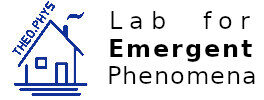
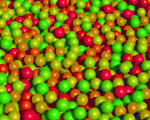 Upon increase of the density or a decrease of the temperature, the dynamics in many systems might slow down dramatically (not only in soft matter systems). We want to understand this breakdown of dynamics in various systems including particulate model systems, but also in more realistic soft materials like colloidal suspensions, gels, and active or living systems. We explore possible links between structure and dynamics, the connection between the slowdown of soft and hard colloids, and its relation to the jamming or crowding transition.
Upon increase of the density or a decrease of the temperature, the dynamics in many systems might slow down dramatically (not only in soft matter systems). We want to understand this breakdown of dynamics in various systems including particulate model systems, but also in more realistic soft materials like colloidal suspensions, gels, and active or living systems. We explore possible links between structure and dynamics, the connection between the slowdown of soft and hard colloids, and its relation to the jamming or crowding transition.